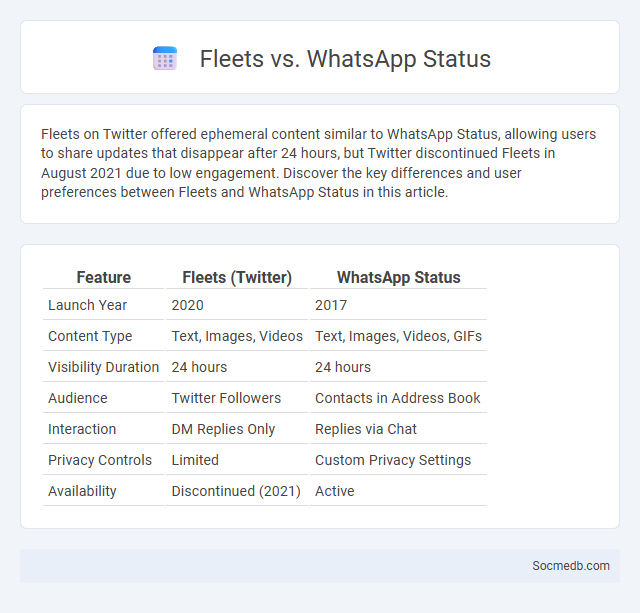
Photo illustration: Fleets vs WhatsApp Status
Fleets on Twitter offered ephemeral content similar to WhatsApp Status, allowing users to share updates that disappear after 24 hours, but Twitter discontinued Fleets in August 2021 due to low engagement. Discover the key differences and user preferences between Fleets and WhatsApp Status in this article.
Table of Comparison
| Feature | Fleets (Twitter) | WhatsApp Status |
|---|---|---|
| Launch Year | 2020 | 2017 |
| Content Type | Text, Images, Videos | Text, Images, Videos, GIFs |
| Visibility Duration | 24 hours | 24 hours |
| Audience | Twitter Followers | Contacts in Address Book |
| Interaction | DM Replies Only | Replies via Chat |
| Privacy Controls | Limited | Custom Privacy Settings |
| Availability | Discontinued (2021) | Active |
Introduction to Fleets, WhatsApp Status, and Stories Features
Fleets, WhatsApp Status, and Stories features allow users to share ephemeral content that disappears after 24 hours, enhancing real-time communication and personal expression across social media platforms. These features support multimedia formats including photos, videos, and text, encouraging engagement through temporary updates and interactive elements like stickers and polls. Popularized by platforms such as Twitter, WhatsApp, and Instagram, ephemeral stories drive user interaction by emphasizing immediacy and authenticity in digital communication.
What Are Fleets? Overview and Key Functions
Fleets are temporary social media posts designed to disappear after 24 hours, similar to stories on platforms like Instagram and Snapchat. They allow you to share fleeting thoughts, updates, or multimedia content without permanently influencing your profile's appearance or algorithmic feed ranking. Key functions include ephemeral visibility, interactive stickers, and quick audience engagement to enhance casual, real-time communication.
WhatsApp Status: Core Features and User Experience
WhatsApp Status allows users to share text, photos, videos, and GIFs that disappear after 24 hours, enhancing ephemeral communication. The feature supports privacy controls, enabling users to customize who can view their updates for a personalized experience. Integration with WhatsApp's end-to-end encryption ensures secure sharing, making it a popular choice among over 2 billion active users globally.
Key Differences: Fleets vs WhatsApp Status
Fleets on Twitter offered ephemeral content visible for 24 hours but were discontinued in August 2021, whereas WhatsApp Status remains an active feature allowing users to share text, photos, and videos with end-to-end encryption for 24 hours. WhatsApp Status emphasizes private sharing within contact lists, leveraging WhatsApp's secure messaging platform, while Fleets aimed for broader public interaction. The key distinction lies in WhatsApp Status's privacy-centric design versus Fleets' now-defunct public storytelling format.
Privacy and Security: Fleets vs WhatsApp Status
Privacy concerns differ significantly between Fleets and WhatsApp Status due to their platform designs; Fleets, as Twitter's ephemeral content feature, offers temporary posts visible only to followers with less granular control over audience settings. WhatsApp Status provides end-to-end encryption and allows users to customize visibility through specific contact lists, enhancing security and limiting exposure. The encrypted messaging infrastructure of WhatsApp creates a more secure environment for sensitive updates compared to the public or semi-public nature of Fleets.
User Engagement: Which Feature Resonates More?
User engagement on social media platforms peaks with features like interactive polls, live videos, and story updates that encourage real-time participation. Your audience responds most actively to personalized content and quick feedback loops, fostering stronger connections and loyalty. Prioritizing these interactive elements drives meaningful conversations and sustained interest.
Content Creation and Customization Options
Social media platforms offer extensive content creation tools, including video editing, image filters, and interactive story features, enabling users to craft personalized posts that resonate with specific audiences. Customization options such as adjustable privacy settings, audience targeting, and post scheduling empower creators to optimize engagement and control content visibility. Leveraging analytics and user insights further enhances content strategy, driving higher reach and interaction rates across channels like Instagram, TikTok, and Facebook.
Cross-Platform Integration and Compatibility
Cross-platform integration enhances your social media strategy by enabling seamless content sharing and consistent messaging across diverse platforms like Facebook, Instagram, Twitter, and LinkedIn. Compatibility features ensure that your posts maintain proper formatting, interactive elements, and optimal display on various devices and operating systems, improving user engagement and reach. Leveraging tools designed for cross-platform management helps streamline scheduling, analytics, and communication, maximizing efficiency and impact of your social media campaigns.
Business and Marketing Opportunities
Social media platforms offer unparalleled business and marketing opportunities by enabling direct engagement with target audiences through personalized content and targeted advertising. Leveraging data analytics, companies can optimize campaigns, track consumer behavior, and refine strategies for higher ROI. You can expand brand visibility, generate leads, and build customer loyalty by utilizing these digital tools effectively.
The Future of Ephemeral Content: Trends and Predictions
Ephemeral content on social media, characterized by disappearing posts and stories, continues to reshape user engagement by fostering authenticity and urgency. Platforms like Instagram, Snapchat, and TikTok are evolving their features to enhance interactive elements such as augmented reality filters, polls, and real-time reactions, driving higher user interaction rates. Experts predict a surge in AI-generated ephemeral content and personalized storytelling, emphasizing real-time experiences and deeper brand-consumer connections.
 socmedb.com
socmedb.com